Hanging baskets have a way of bringing life to every corner, and trailing succulents make them even more magical. Their flowing stems, playful shapes, and vibrant colors can soften a balcony, brighten a kitchen window, or create a lush focal point in your living room.
These plants aren’t just beautiful; they’re also wonderfully low-maintenance, making them perfect for busy days. You’ll find options here that cascade like green waterfalls, twist into intriguing shapes, or pop with flowers that surprise you through the year.
Most are happy with a sunny spot and occasional watering, rewarding you with growth that feels effortless. Pick a few, mix textures, and watch your hanging garden turn into a living art piece.
#1 String Of Hearts (Ceropegia Woodii)
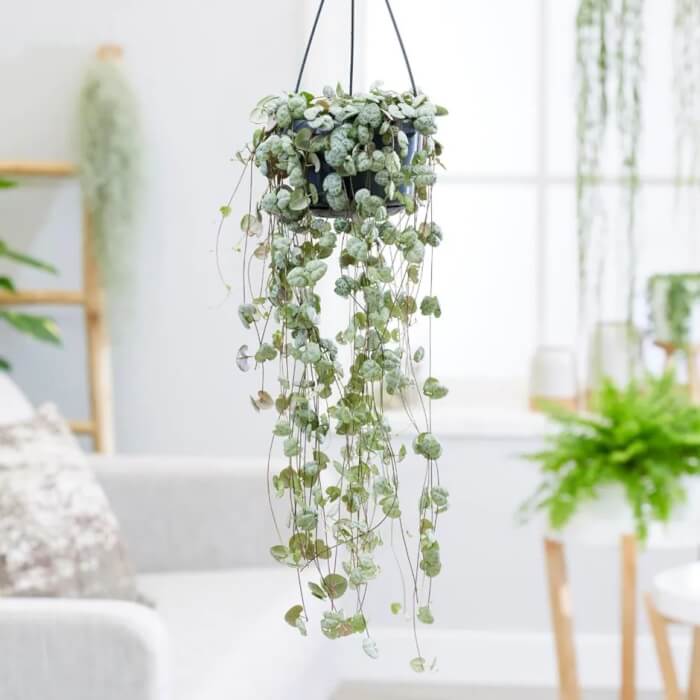
Delicate vines dotted with tiny, heart-shaped leaves give this plant its name. The mix of silver, green, and purple shades adds depth, making every strand worth admiring.
Give it bright, indirect light to keep the colors vivid. Let the soil dry before watering to prevent root rot. If you want a fuller basket, pinch back the vines to encourage branching.
#2 Hindu Rope (Hoya Carnosa Compacta)
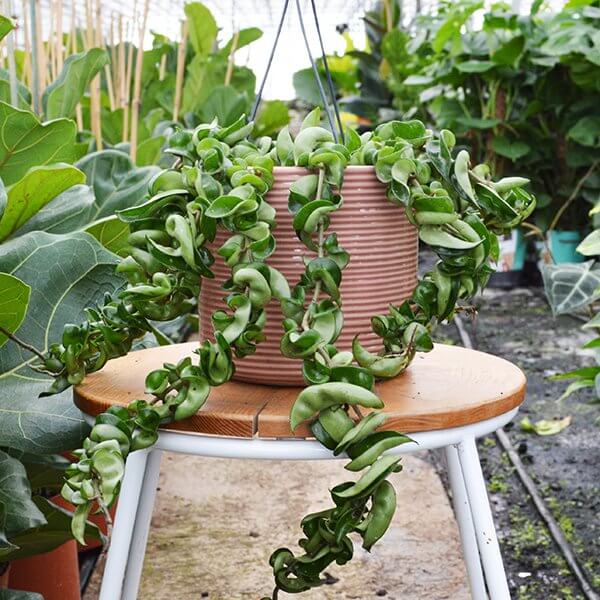
This variety charms with its thick, glossy leaves that curl and twist into rope-like chains. The foliage can be deep green or splashed with creamy white variegation.
It loves bright light and will reward patience with clusters of fragrant, star-shaped flowers. Water sparingly, allowing the soil to dry between drinks. For more growth, feed monthly during spring and summer.
#3 String Of Tears (Senecio Herreianus)
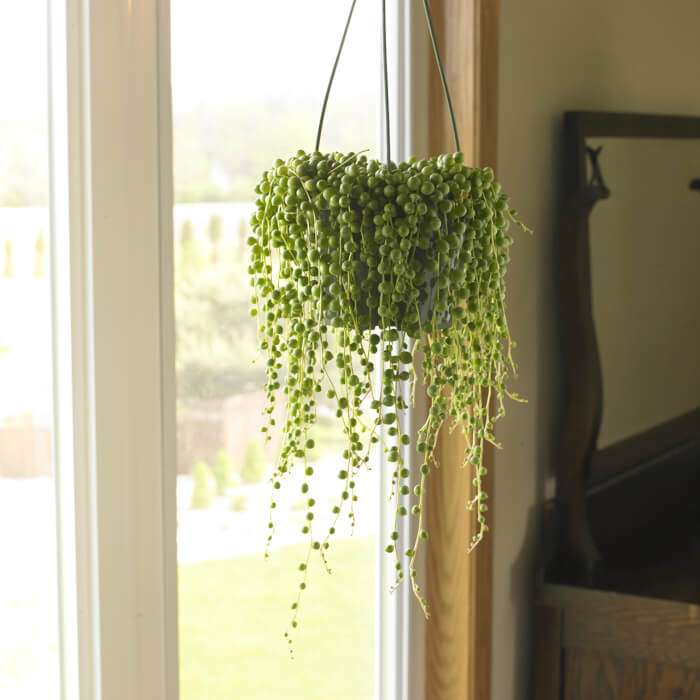
Small, teardrop-shaped leaves line thin, trailing stems, creating a graceful drape. The plant grows slowly, so you can enjoy its compact beauty for years.
Place it somewhere with gentle sunlight and well-draining soil. Water when the top inch feels dry. You can easily propagate it by laying a cutting on fresh soil and misting until roots form.
#4 Peanut Cactus (Echinopsis Chamaecereus)
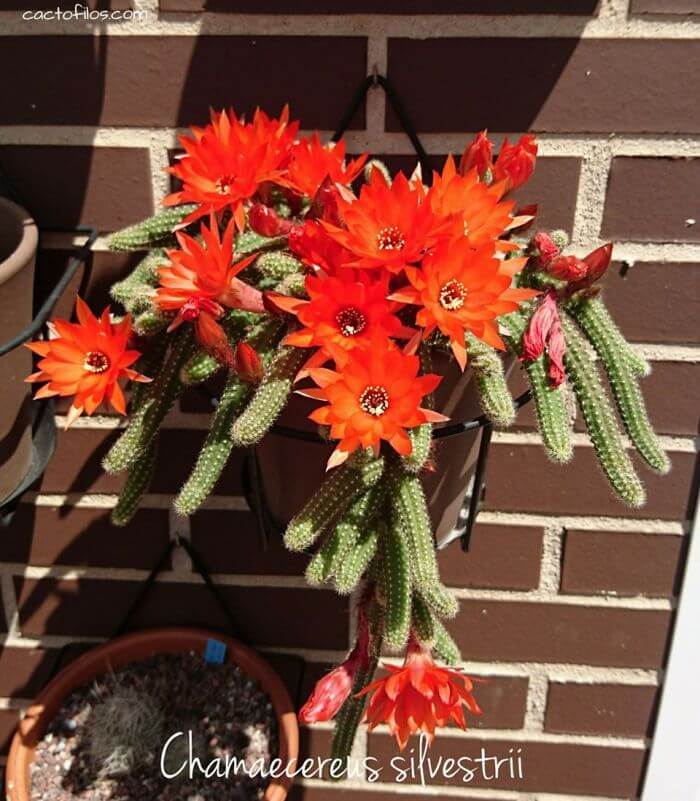
Short, finger-like stems cluster together and are covered in soft, white bristles. They’re safe to touch, making this cactus kid- and pet-friendly.
It thrives in bright light and benefits from occasional fertilizer in summer. Let the soil dry before watering deeply. Over time, the stems will spill over the edges of the basket in charming bunches.
#5 Elephant Bush (Portulacaria Afra)
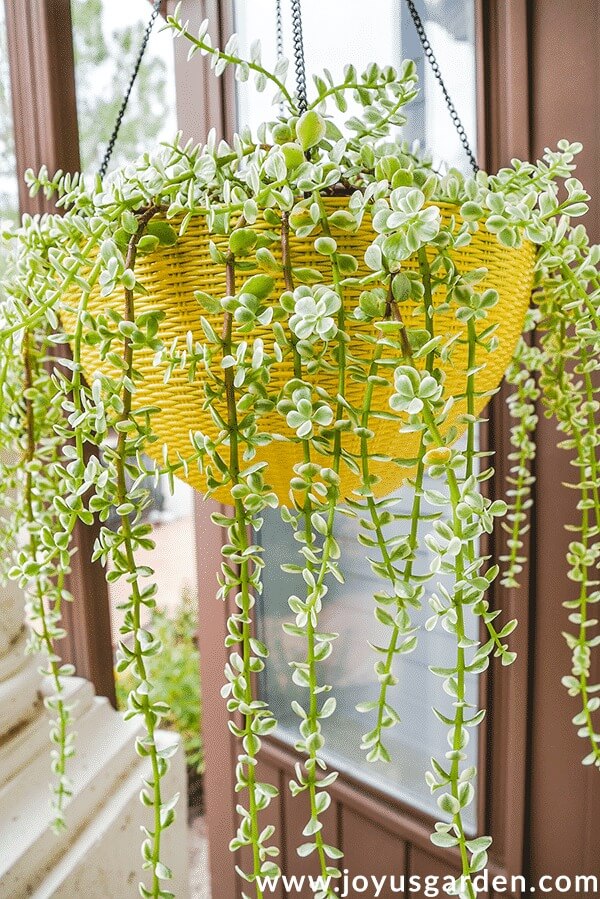
Glossy, rounded leaves sit along reddish-brown stems that can grow outward or downward. It’s a forgiving plant that adapts to various light conditions but grows best in bright, indirect sun.
Water only when the soil is completely dry. To shape it, trim the stems in spring; you can plant the cuttings in fresh soil to start new baskets.
#6 Ruby Necklace (Othonna Capensis)
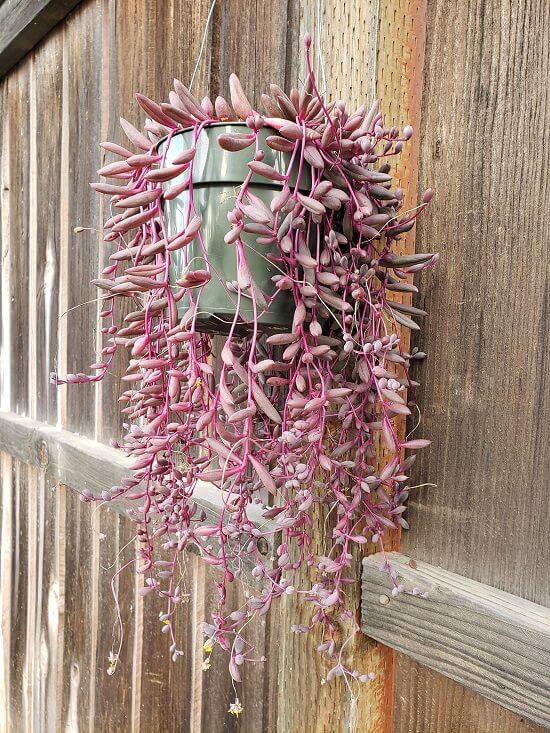
Slender, bean-shaped leaves shift from green to deep purple when exposed to sun stress, creating a jewel-like display. Its bright yellow, daisy-like flowers add a playful contrast.
Give it a sunny window or balcony spot for the best color. Let the soil dry well before watering. Pruning back long strands will keep it lush and vibrant.
#7 Variegated Trailing Jade (Crassula Sarmentosa)
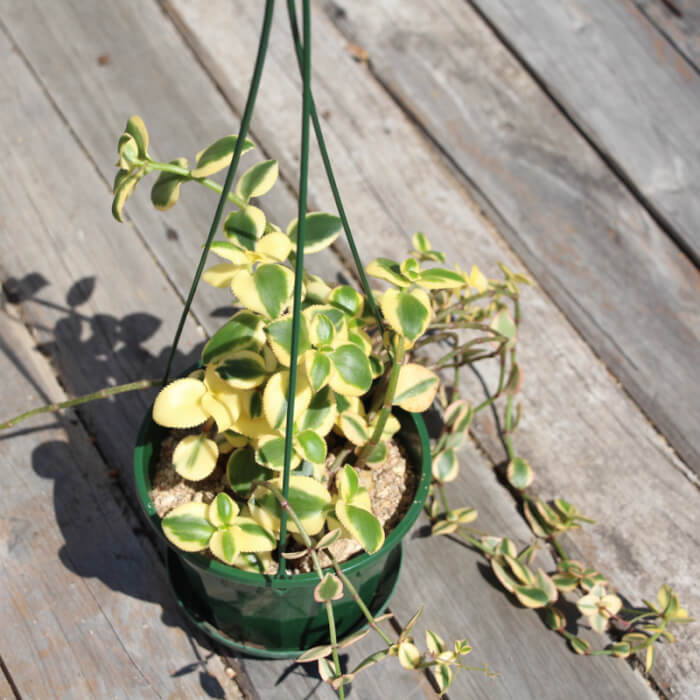
Oval leaves edged in creamy yellow and tipped with pink brighten up any basket. In late autumn, clusters of small white flowers appear, adding seasonal charm.
Place it in full to partial sunlight for stronger colors. Water thoroughly, then wait until the soil is dry before watering again. Remove faded blooms to keep it tidy.
#8 Christmas Cactus (Schlumbergera Bridgesii)
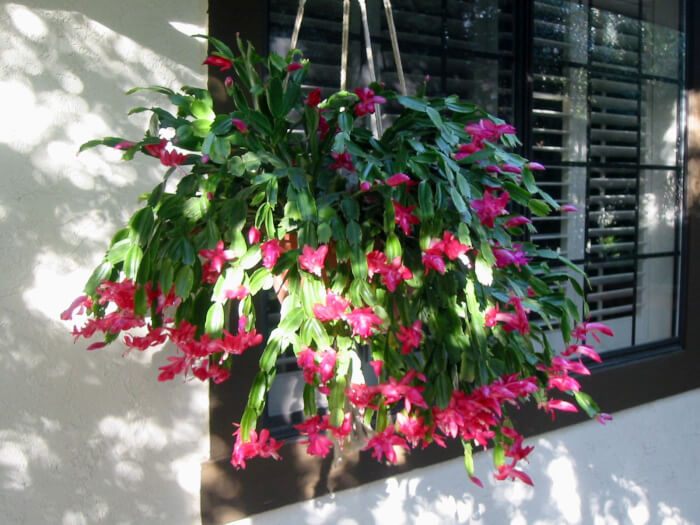
Flat, segmented stems arch gracefully and burst into blooms near the holiday season. Flower colors range from soft pink to deep red, often with a glowing center.
Keep it in bright but indirect light and water when the topsoil feels dry. After blooming, allow a short rest period with less water to prepare it for next year’s show.
#9 String Of Nickels (Dischidia Nummularia)

Round, coin-like leaves cascade in strands, giving this plant its charming name. Colors shift from pale green to bronze, adding warmth to your display.
It likes moderate light and slightly moist soil, but never let it sit in water. Hang it where the air flows freely to keep the foliage fresh and healthy.
#10 Porcelain Flower (Hoya Pachyclada)
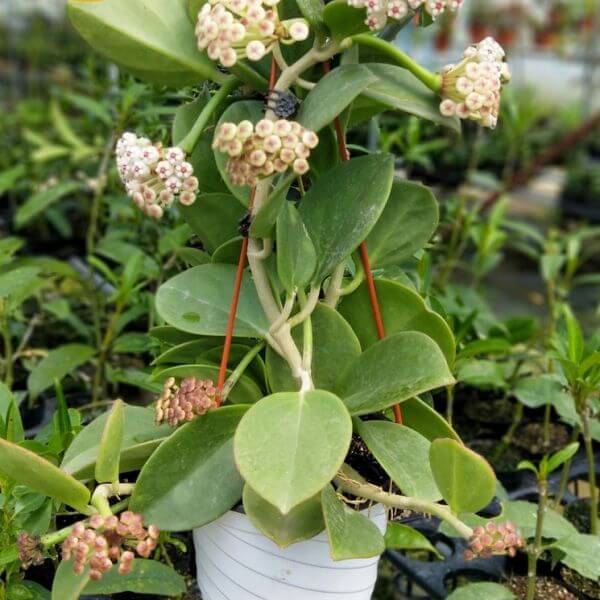
Thick, round leaves edged in red make this plant striking even without blooms. When it flowers, clusters of creamy white stars form perfect balls with a sweet citrus scent.
Provide plenty of bright light to encourage blooming. Let the soil dry out before watering, and keep it in a snug pot to promote more flowers.
#11 Rattail Cactus (Aporocactus Flagelliformis)

Thin, flexible stems can grow several feet long, covered in fine spines. In spring, vivid pink, tubular flowers appear along the stems.
Place in full sun for the healthiest growth. Water only when the soil is completely dry, and avoid handling the stems too often to protect the blooms.
#12 Burro’s Tail (Sedum Morganianum)
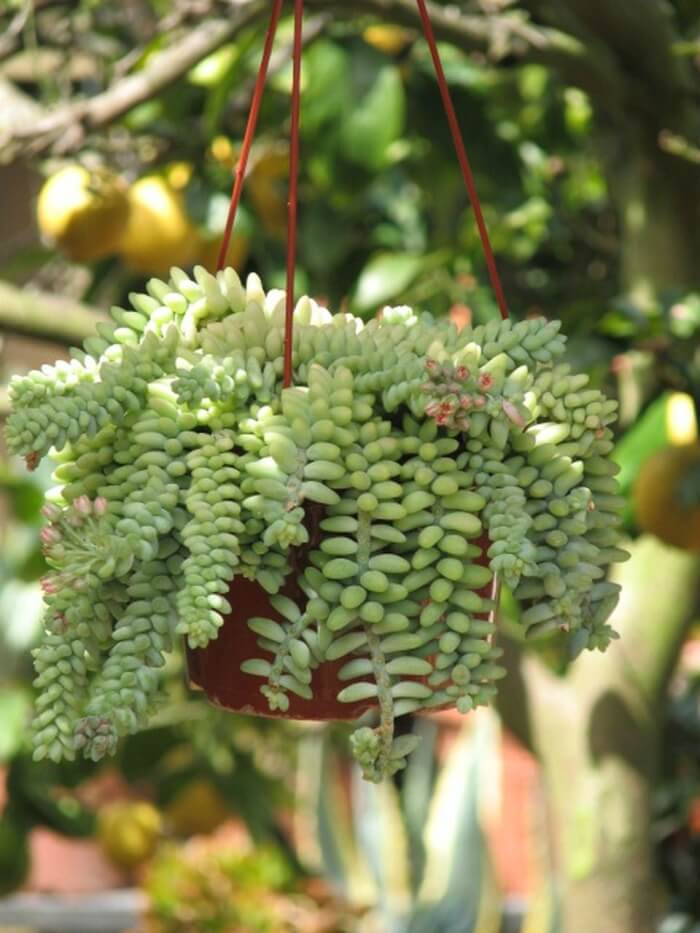
Plump, overlapping leaves create thick, trailing stems that drape beautifully over baskets. The pale blue-green leaves are dusted with a natural wax that adds a soft sheen.
Keep it in bright light and water sparingly to avoid leaf drop. For fuller growth, gently tuck fallen leaves into the soil to root new plants.
#13 October Daphne (Sedum Sieboldii)
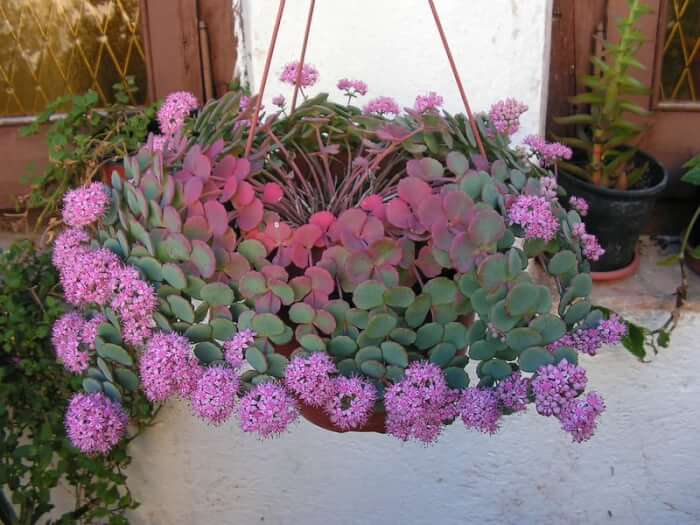
Round leaves tinged with pink circle the stems in groups of three. In autumn, clusters of bright pink flowers appear, making it a seasonal favorite.
Give it a sunny spot and well-draining soil. Reduce watering in cooler months to prevent rot. Trim after blooming to keep its shape neat.
#14 Sedum Little Missy
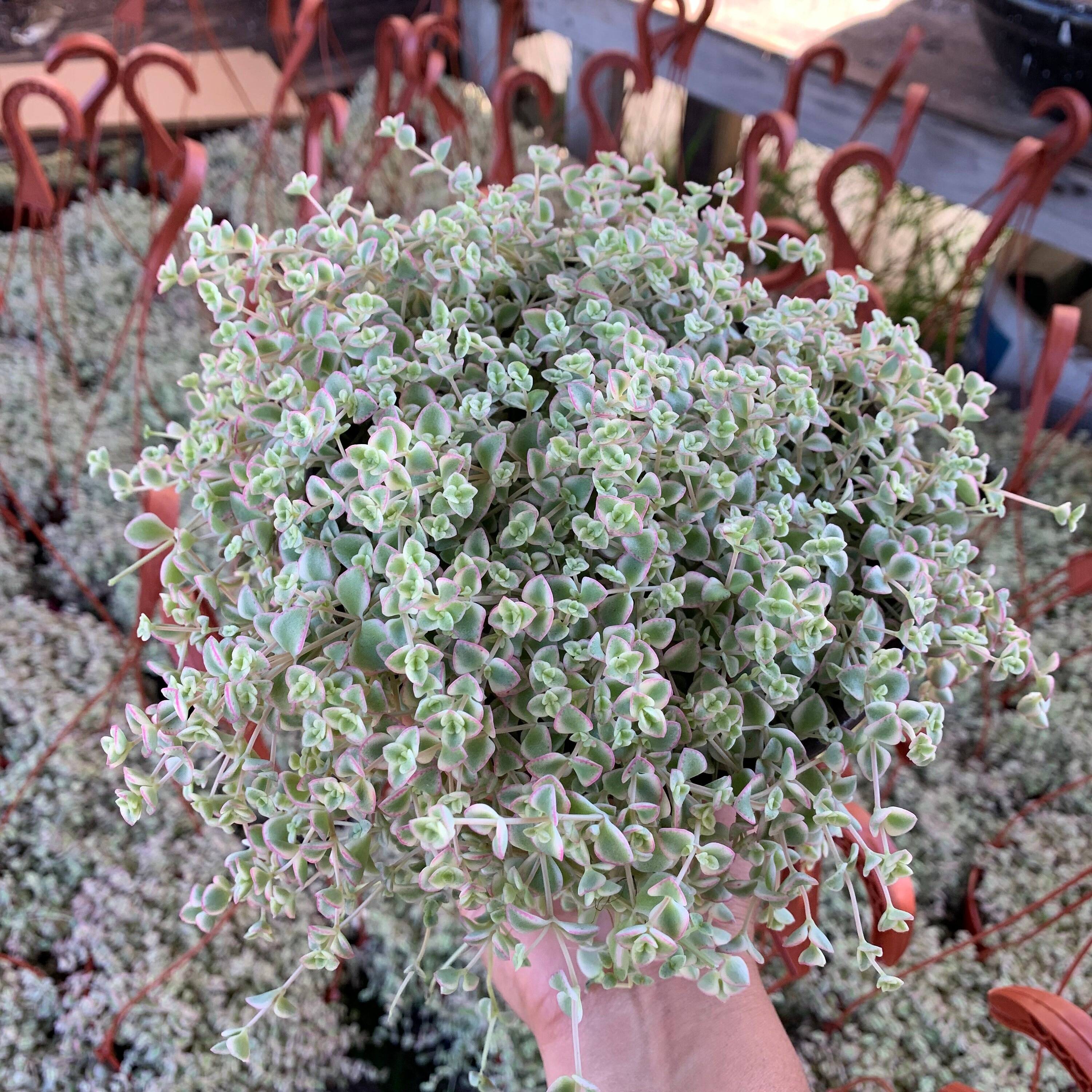
Tiny, heart-shaped leaves with pink edges form dense mats that trail over basket edges. This sun-loving plant thrives with minimal care.
Water lightly once the soil is dry. If stems get too long, pinch them back to encourage new growth and maintain a compact look.
#15 Crassula Pellucida Variegata
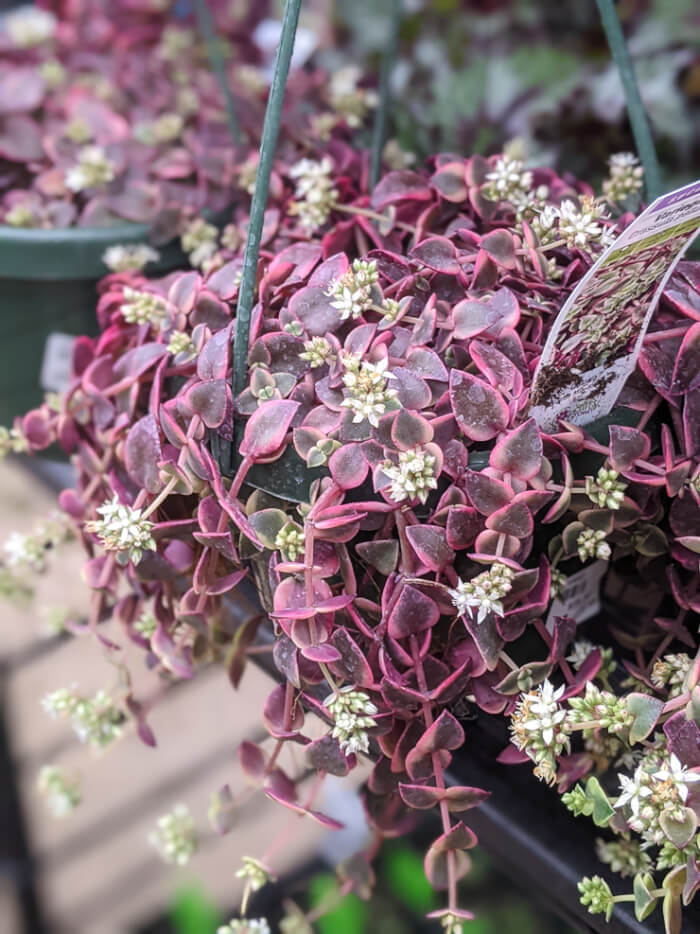
Delicate, heart-shaped leaves come in a blend of rose, pink, cream, and green. The colors intensify with more sunlight.
Keep it in bright light for best results and let the soil dry before watering again. You can easily root cuttings in fresh soil to share with friends.
#16 Lantern Flower (Ceropegia Haygarthii)
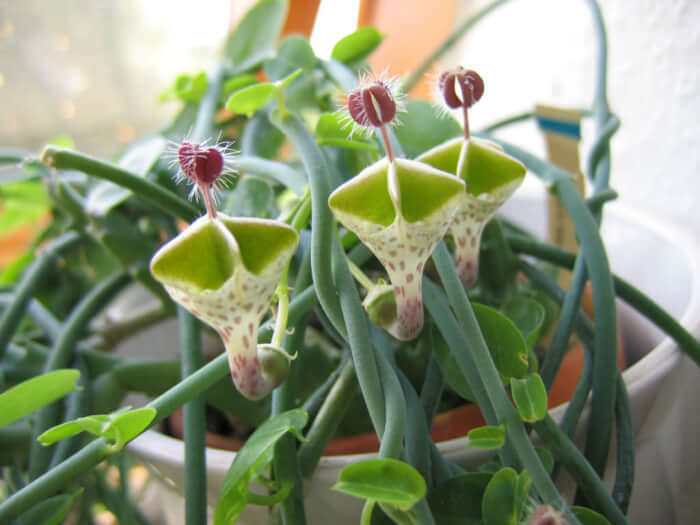
Its unusual blooms resemble tiny lanterns, each with intricate patterns and soft colors. The flowers also attract pollinators.
Provide bright, indirect light and allow soil to dry between waterings. Give it a trellis or let it spill naturally over the basket for a wild, graceful effect.
#17 String Of Pearls (Senecio Rowleyanus)
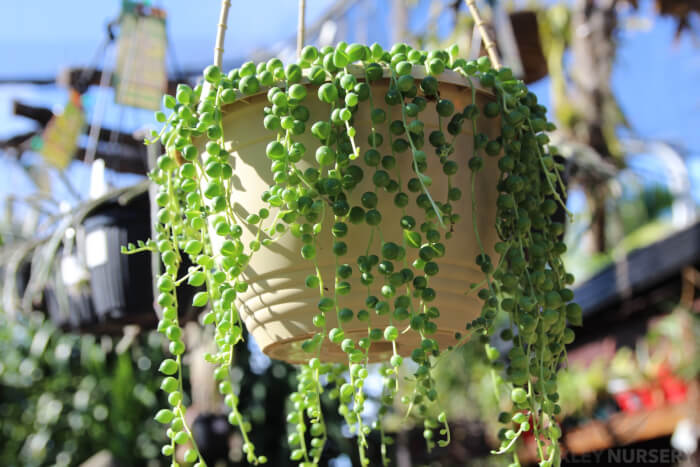
Perfectly round, pea-like leaves line long, slender stems, giving the illusion of green beads. Small, white blooms with a cinnamon-like scent appear with enough light.
Place it in a sunny window and water sparingly. To keep it full, plant multiple strands together in one basket.
#18 String Of Buttons (Crassula Perforata)
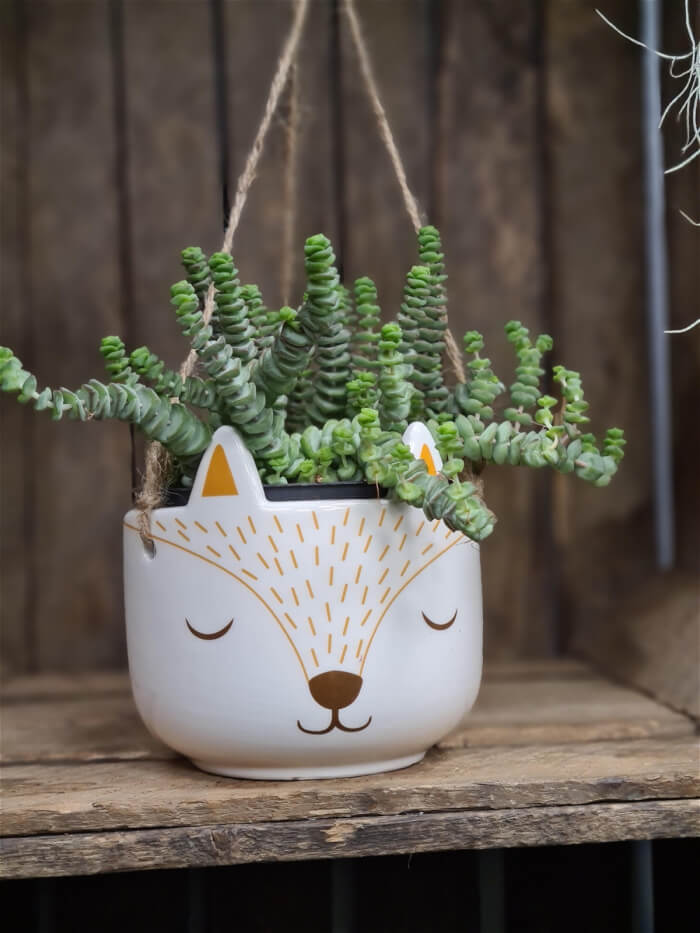
Triangle leaves stack neatly around the stem, spiraling upward with pink-tinted edges. Bright light keeps the colors sharp.
Water thoroughly, then wait until dry to water again. You can trim and replant the tops for a fuller, layered look.
#19 Dancing Bones (Hatiora Salicornioides)
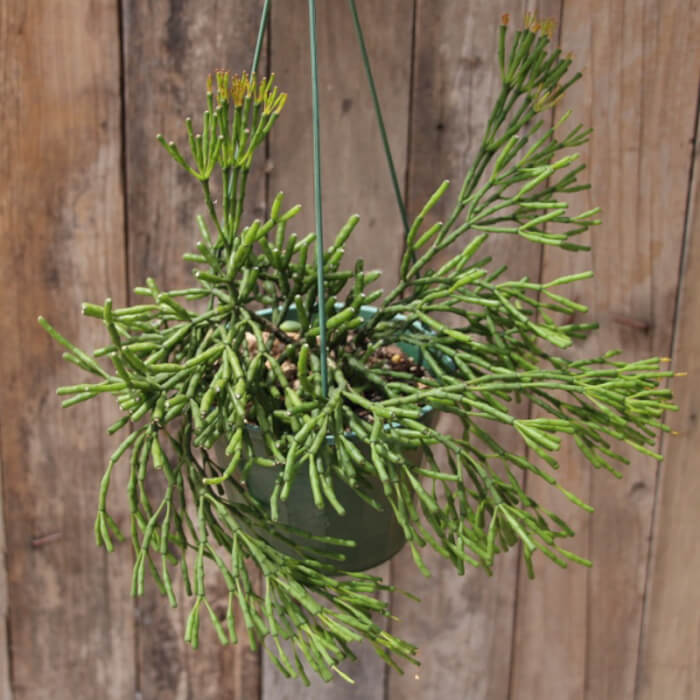
Quirky, segmented stems twist and branch into playful shapes. In cooler seasons, small yellow blooms appear at the tips.
Give it partial sun and water only when the soil feels dry. Light pruning after flowering will keep it looking fresh.
#20 String Of Bananas (Senecio Radicans)
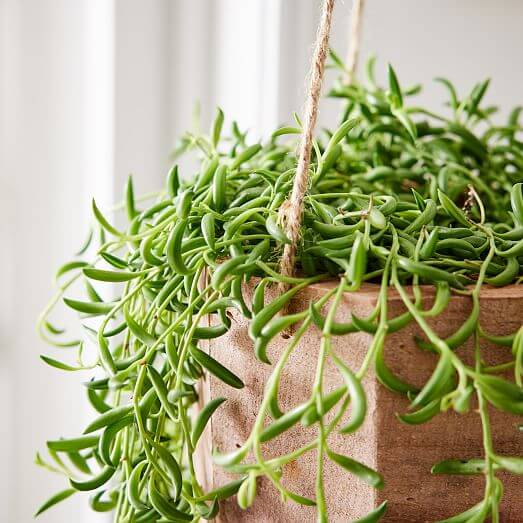
Curved, banana-shaped leaves spill over the sides in abundant strands. It grows quickly in bright light and well-draining soil.
Water when dry, and feed monthly during the growing season for lush growth. Trim regularly to prevent tangling.
#21 Monkey’s Tail (Hildewintera Colademononis)
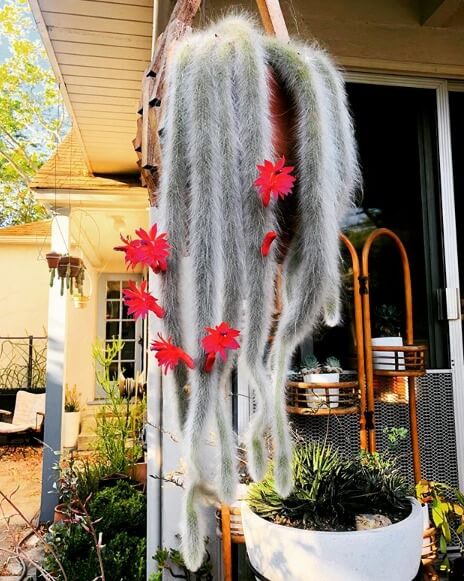
Long, thick stems covered in soft white spines create a dramatic waterfall effect. In winter, large red flowers add a bold contrast.
It thrives in bright light with occasional deep watering. Use a sturdy hook for hanging, as mature plants can become heavy.
#22 Ice Plant (Dorotheanthus Bellidiformis)
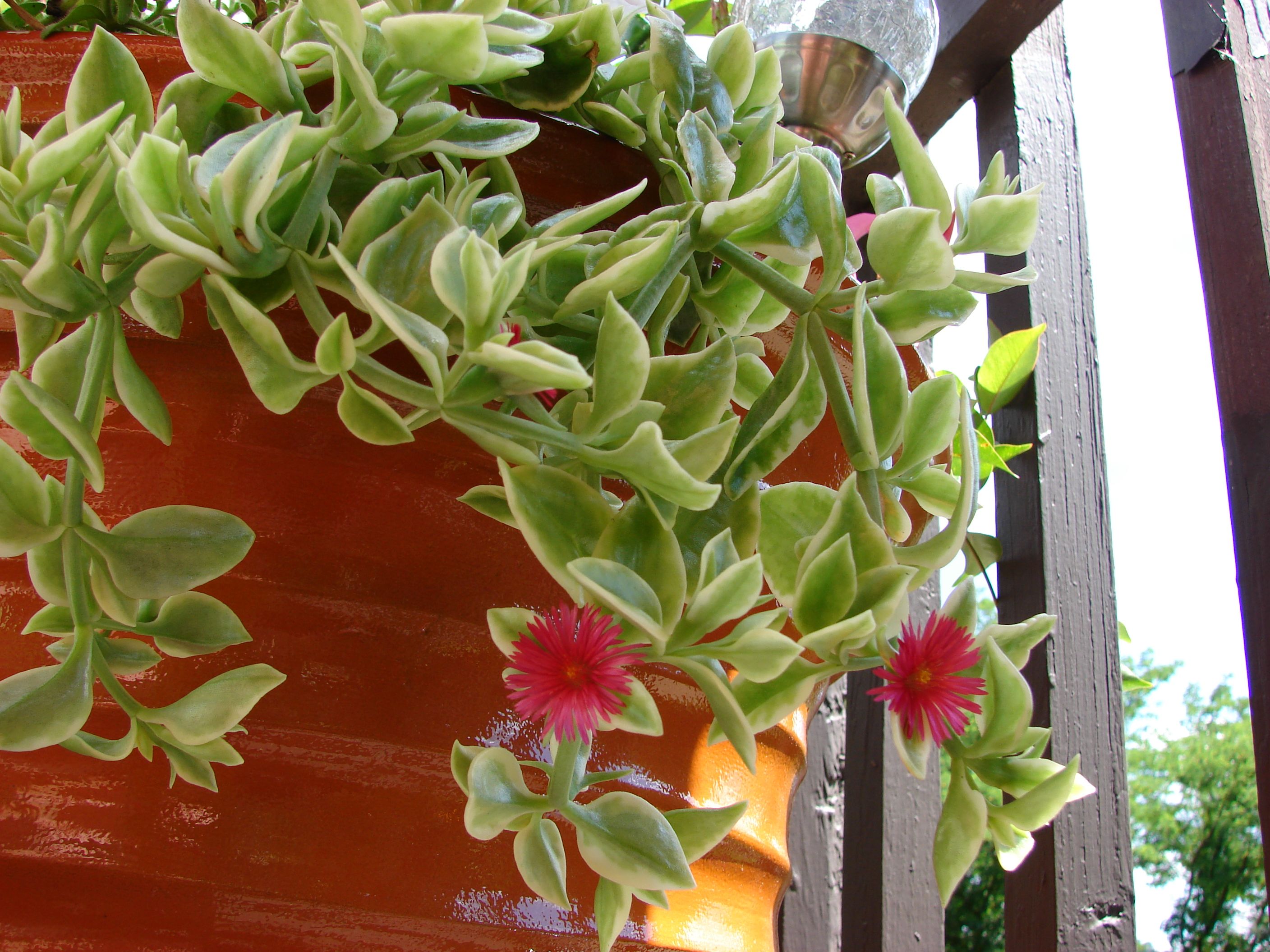
Glossy, bead-like foliage glistens as if covered in ice, giving it a unique texture. Vibrant, daisy-like blooms cover the plant in bright shades through warm months.
Place it in full sun for the best display. Keep soil slightly moist but never soggy, and deadhead spent blooms to encourage more flowers.
